-
×
 £20 Gift Voucher
1 × £20.00
£20 Gift Voucher
1 × £20.00
Understanding and Caring for Wraps
Creases: Perma Creasing, Wash Creasing and Threadshifting in Woven Wraps
There are two terms that are a regular part of the babywearing vocabulary relating to movement of threads in the cloth structure- “perma-creasing” and “thread-shifting”. We’ve identified a 3rd different type of creasing too- wash creasing. This is often mis-described as perma-creasing, but the two are quite distinct. It is useful for us all to be on the same page when it comes to using terminology, so here are our definitions:
Definitions of Different Types of Creasing
- Perma-creasing: Small, recurrent crease lines in the wrap that remain permanently visible or are hard to ever fully iron out. These are created over time at the points where the wrap naturally, repeatedly creases or folds during use, or whilst stored for long periods. The constant creasing n the same spot causes the warp threads to shuffle together, leaving a line of weft thread exposed along the ridge of the crease. They are more common along the rails of a wrap, especially around the central top section where the rail concertinas at the child’s upper torso. This creasing is mostly just cosmetic but in extreme cases can create areas of weakness because it exposes the weft threads to greater wear and tear.
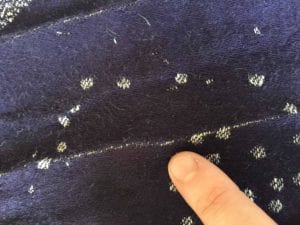
2.Thread-shifting: Whilst any crease is caused by the threads shifting position slightly, this is movement in larger patches in isolated areas of the wrap. The warp threads cluster together creating dense areas and open areas that let light through. Can occur particularly in areas of pattern change during washing, or as a result of a localised pressure on one spot in the cloth eg. a single thumb or finger pulling the wrap up against the weight of the child. These tend to occur in a single instance rather than build up over time, and are usually easier to permanently repair. Patches of unfixed thread shifting can become weaker than other areas and make it easier for secondary damage to occur.
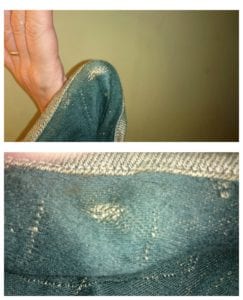
3. Wash-creasing: The warp threads are all evenly spaced out during weaving, and they show an even amount of the weft through them. Sometimes during a first wash, the fabric will twist and crease, and the warp threads move apart a tiny, tiny, fraction. This tiny change is too small to effect the structure of the cloth, it just shows a bit more weft thread on the warp face of the cloth, so you get a row of dots of weft that appear to form a line. As the threads have moved so little, it is really hard to move them back by hand- you are talking such small increments of movement.
In this way, wash creasing is only a visual issue- it doesn’t affect the integrity or structure of the cloth at all, and it is pretty common with long fibre threads (hemp/linen) because they can’t move as much as the cotton threads can, so they stay static while the cotton warp bends, and that causes a crease during washing. Once the cloth has ‘set’ after a wash or two it doesn’t continue to happen in future washes, and the look of them softens into part of the design. You can also minimise the look of that creasing which has already occurred with some very intense ironing of the cloth when damp (really push and put effort in, not just a smooth over) to try and shuffle the moved thread back in place a bit. As you’re talking fractions of a millimetre it can’t really be done so easily with a pin like you would fix perma creasing or threadshifting. I recommend spraying with a misting of water to dampen the area, then a steam iron over in all directions.
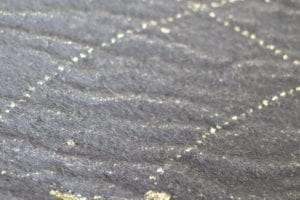
Preventing, Minimising and Mending Creasing
In order to both prevent and repair creases, we need to examine what exactly is happening when cloth creases and threads shift.
Creases occur in cloth when heat and water break down the bonds that hold fibres in place, allowing them to move into new positions and be less evenly spaced. As they dry and cool they lose that mobility and stay in their new place. Reintroducing heat/water and flattening the fibres or moving them back into their original position individually removes the creasing. Cloth is made up of lots of individual intersecting threads that we see as a single, solid object. Tiny changes in the distance between the threads will affect the strength of colour and appearance of the cloth. A crease may let more dots of weft show through the warp, or have an area where the warp threads are more densely packed together and that subtle difference to the area around it will create the appearance of a line in the cloth.
A good example of how subtle differences can affect appearance would be the weft lines visible in some handwoven wraps. The weft colour appears stronger where the weft threads have been beaten more tightly together during weaving. The regular ‘waves’ of colour across the wrap show the rhythm of the weaver, like a heartbeat trace. When viewed up close, the difference in distance between the threads that causes this effect is almost imperceptible, and it demonstrates how minor differences in weave can affect appearance without affecting function in any way.
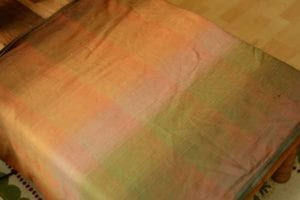
Warp threads run the length of your wrap, and the weft goes for rail to rail in between those warp threads. Cloth is woven under tension and some of this tension remains in the cloth; all the threads are just sat there politely, in the position that they had been put by the loom. At this point, they haven’t bonded with their neighbours or found their comfy spot. They can more easily be pushed into different places by your finger. Once they’ve had a bath, lots of that artificial tension dissipates and the threads change quite dramatically. They shrink down to their natural, unstretched state, they become more friendly with the threads that intersect them, they find a more permanent spot to reside in.
Different threads will settle in different ways. In general, threads that have lots of natural movement (short fibres, plied threads made out of several strands twisted together) are more easy going and biddable. Yarns that are stiffer ( long fibred threads, thicker single ply threads) find it harder to move with everyone else. Hollow fibres that absorb water more easily will be more easily distorted by a wash.Tight weave cloth traps both threads and holds them tightly so that they have reduced movement, whereas looser weaves give the threads more of a free reign.
We can see then how some wraps might be more prone to creasing and ‘uneven’ movement than others. As the stiffer threads break in and soften, then become better ‘team players’ and move with the rest of the fabric. As cloth knits together over time they form a plan for how to stay together during washes and generally work together as a little team!
Minimising Wash-creasing.
There are several ways that we can tackle this. We know that the key elements when it comes to creasing are heat & water to loosen the fabric, then positioning that determines the new positions that the threads adopt. Minimising the distortion caused by the cloth twisting and knotting during the washing phase can avoid the creases occurring, and flattening out any creases whilst the cloth is still more mobile will prevent them from setting. THIS ADVICE IS FOR NON-WOOL WRAPS. You shouldn’t find that wool wraps develop wash creasing at all as it isn’t a characteristic of that kind of cloth.
- Wash in a delicates laundry bag, especially for the first wash.
- Wash on a wool cycle. This cycle type reduces movement of the cloth so that creases aren’t wrung into the wrap.
- Keep spin cycles reasonably low and gentle.
- Re-shape the cloth after washing and before drying. We’d recommend stretching out cloth when it leaves the washing machine before line or tumble drying. Stretching the cloth diagonally in both directions helps to settle the weave again. I usually ‘walk’ my hands along the length of the cloth, stretching diagonally in one direction then the other. Never fully dry the cloth, remove from a tumble dryer when still damp
- Iron whilst still damp on a high heat without steam and continue until completely dry. The wrinkles will start to reappear if the cloth isn’t dry enough
- For creased wraps that are already dry, dampen and use a hot steam iron to re-mobilise any creased areas, then move the threads into their true position either with the iron or manually (See moving threads below) and allow to cool/dry. You can read more about wash creases in a wrap here
Minimising Perma-creasing
Prevention is the key here- avoid storing wraps with their rails creased after use and regulary iron crease-prone wraps.
If you already have creases in place you need to re-educate the threads through dampening/heating and then moving the threads back to their proper positions (see ‘moving threads below).
Minimising Thread-shifting
Wash new wraps to encourage them to pull together and become less mobile before you use them. Avoid pulling on the wrap with a single thumb/finger as you wrap- try to distribute the pressure across a wider area.
Treat areas of thread shifting by mobilising the threads with heat/water, then moving the threads back to their true position and allowing to cool/dry in their new place.
Moving threads back into position.
As a first resort, you can manipulate the shifted threads by grasping the cloth on either side and making circular movements to encourage thread back into their places.
You may need to physically push the threads back into their places. It is easiest to do this with a blunt needle or similar ‘pointy but not snaggy’ object. There are probably more threads involved that you anticipate. There are some threads that have quite clearly moved, in the centre of the shift, but there will also be threads around the affected area that have been shuffled almost imperceptibly closer to each other. You will need to space these out again too in order to ‘refill’ the thread shifted area.
In some weaves, you can use the weft face to determine the original spacing of the threads. The weave creates little dots of warp thread in diagonal lines and by making sure that these dots are evenly spaced you can correct the thread shifting.
Steam ironing will help to reset the threads in their new positions.
Ultimately, woven structures are incredibly strong and resilient, and there is little that can’t be sorted with a little know-how and confidence…
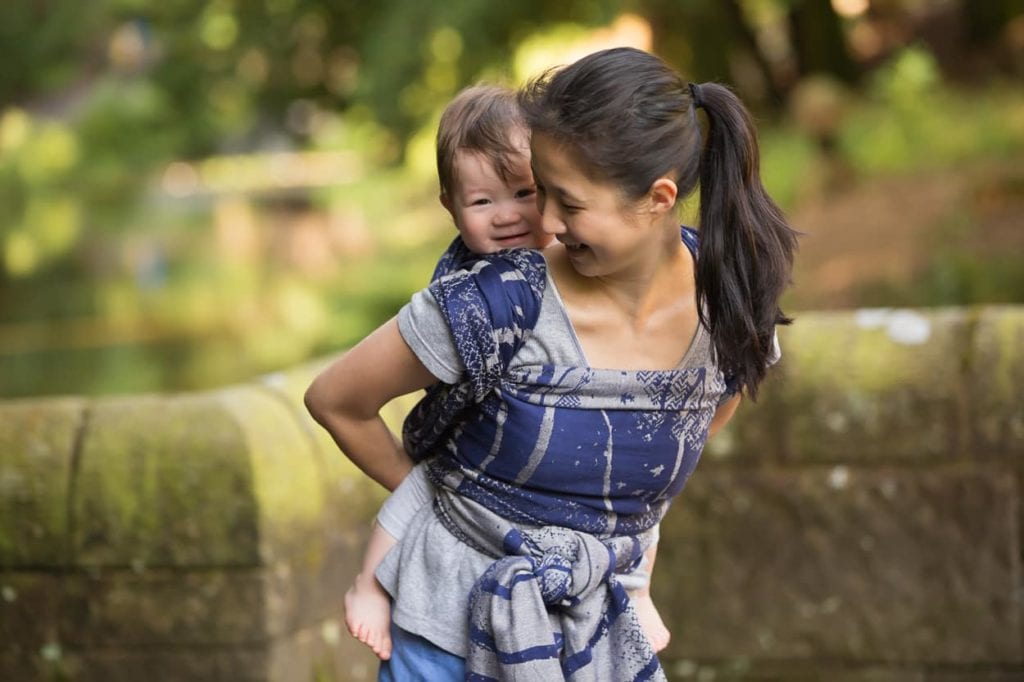
Keep these areitlcs coming as they’ve opened many new doors for me.